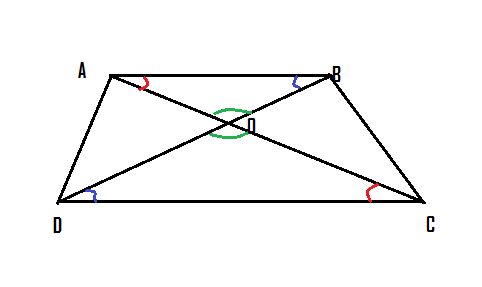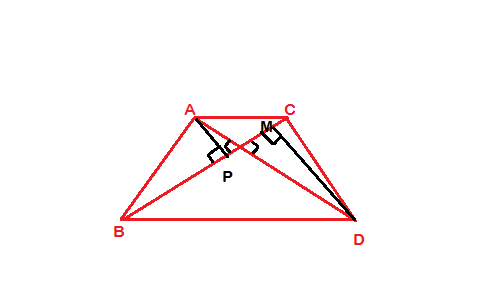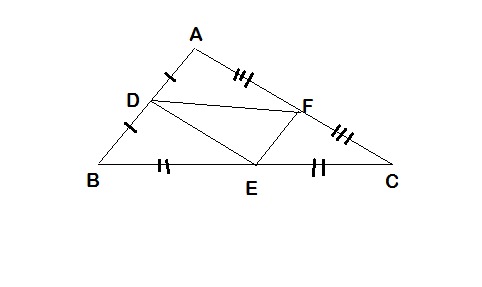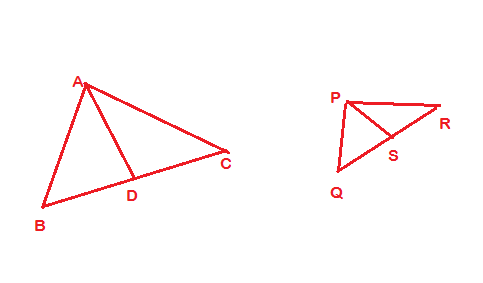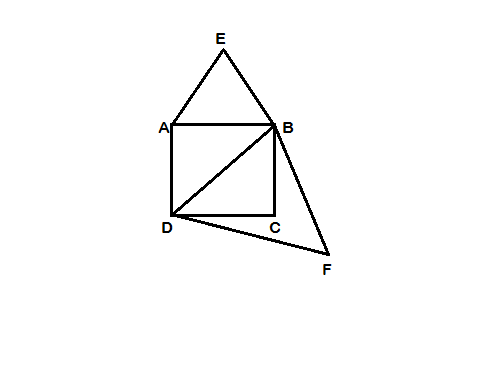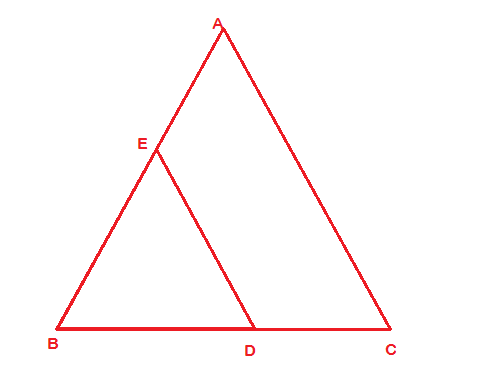SOLUTIONS
1. Let ∆ABC ~ ∆ DEF and their areas be, respectively, 64 $cm^2$ and 121 $cm^2$. If EF =15.4 cm, find BC. If two triangles ∆ABC and ∆DEF are similar, then ${ar(ABC)}/{ar(DEF)}=({AB}/{DE})^2= ({BC}/{EF})^2 = ({CA}/{DF})^2$ $64/121 = ({BC}/{15.4})^2$ $√(64/121) = ({BC}/{15.4})$ ${BC}/15.4 = 8/11$ $BC = 11.2$ $cm$2. Diagonals of a trapezium ABCD with AB || DC intersect each other at the point O. If AB = 2 CD, find the ratio of the areas of triangles AOB and COD.
In trapezium ABCD, AB || DC, and AC and BD are diagonals. Therefore ∠BAO = ∠DCO ∠ABO = ∠CDO ∠AOB = ∠COD Therefore by AAA criteria, ∆AOB is similiar to ∆COD. ${ar(ABC)}/{ar(COD)}=({AB}/{DC})^2$ = $(2/1)^2$ =$4/1$3. In Fig.,ABC and DBC are two triangles on the same base BC. If AD intersects BC at O, Show that ${ar (ABC)}/{ar (DBC)}={AO}/{DO}$
In fig. ABC and DBC are two triangles on the same base BC. Let AP and DM are two perpendiculars drawn to base BC. ${arc(ABC)}/{arc(DBC)}$ = ${1/2× BC× AP}/{1/2 ×BC× DM}$ ${arc(ABC)}/{arc(DBC)}$ = ${ AP}/{DM}$ ..........(1) In ∆APO and ∆DMO, ∠APO =∠DMO ∠AOP = ∠DOM Therefore by AA similiarity , ∆APO ~ ∆DMO $.^{.}.$ ${AP}/{DM}={AO}/{DO}$ Substituting in eqn (1), we get ${arc(ABC)}/{arc(DBC)}$ = ${ AO}/{DO}$ Hence Proved4. If the areas of two similar triangles are equal, prove that they are congruent. Let the triangle be ∆ABC and ∆DEF. Since the triangles are similiar, therefore ${ar(ABC)}/{ar(DEF)}=({AB}/{DE})^2= ({BC}/{EF})^2 = ({CA}/{DF})^2$ Since the area's of two triangles are equal, so, $1=({AB}/{DE})^2= ({BC}/{EF})^2 = ({CA}/{DF})^2$ $({AB}/{DE})= 1$ => $AB=DE$ $ ({BC}/{EF}) = 1$ => $BC = EF $ $({CA}/{DF})= 1$ => $CA = DF $ Also since the triangle be ∆ABC and ∆DEF are similiar, ∠A = ∠D ∠B = ∠E ∠C = ∠F So, if two triangles are congruent then they will have exactly the same three sides and exactly the same three angles. Therefore ∆ABC and ∆DEF are congruent. Hence Proved.5. D, E and F are respectively the mid-points of sides AB, BC and CA of ∆ABC. Find the ratio of the areas of ∆DEF and ∆ABC.
In ∆ABC , D, E, F are the midpoint of the side AB, BC and CA. Therefore in triangles, ∆ABC and ∆DBE, since DE || AC, ∠BAC = ∠BDE ∠ACB = ∠DEB ∠ABC = ∠DBE Therefore by AAA criteria, ∆ABC and ∆DBE are similiar. Hence ${ar(BDE)}/{ar(ABC)} = ({BD}/{AB})^2$ Since BD = $1/2$AB ${ar(BDE)}/{ar(ABC)} = 1/4$6. Prove that the ratio of the areas of two similar triangles is equal to the square of the ratio of their corresponding medians.
Let ∆ABC ~ ∆PQR. AD and PS be the medians of the triangle. Therefore ${AB}/{PQ}={BC}/{QR}={CA}/{RP}$ .....(1) and ∠A =∠P , ∠B=∠Q , ∠C=∠R .............(2) AD and PS are medians of the triangles. Therefore , $BD=DC=1/2{BC}$ and $QS=SR=1/2QR$ therefore eqn (1) becomes, ${AB}/{PQ}={BC}/{QR}={CA}/{RP}$ => ${AB}/{PQ}={BD}/{QS}={CA}/{RP}$ In ∆ABD and ∆PQS, ∠B=∠Q , ${AB}/{PQ}={BD}/{QS}$ so, by SAS similiarity , ∆ABD ~ ∆PQS Therefore, ${AB}/{PQ}={BD}/{QS}={DA}/{SP}$ and ${ar(∆ABC)}/{ar(∆PQR)}$ = ${AB^2}/{PQ^2}={BC^2}/{QR^2}={CA^2}/{RP^2}$ Since ${AB}/{PQ} = {DA}/{SP}$ Therefore, ${ar(∆ABC)}/{ar(∆PQR)}$ = ${AD}^2/{PS}^2$ Hence Proved7. Prove that the area of an equilateral triangle described on one side of a square is equal to half the area of the equilateral triangle described on one of its diagonals.
Let ABCD be the square with sides $a$ unit. Therefore, diagonal = √2$a$ unit Let the equilateral triangle formed by one side of the square be ∆ABE. and the equilateral triangle formed by one of the diagonal be ∆BDF. The length of each sides of the ∆ABE will be $a$ unit and length of each sides of the ∆BDF will be √2$a$ unit Since both the triangles are equilateral triangles, therefore ∆ABE~∆BDF Therefore ${ar(ABE)}/{ar(BDF)}$ = $({a}/{√2a})^2$ => $1/2$Tick the correct answer and justify : 8. ABC and BDE are two equilateral triangles such that D is the mid-point of BC. Ratio of the areas of triangles ABC and BDE is (A) 2 : 1 (B) 1 : 2 (C) 4 : 1 (D) 1 : 4
Both the triangles are equilateral and each angles are $60^0$. Therefore by AAA similarity, ∆BCA~∆BDE. Let the sides of ∆ABC be $x$ , Therefore the sides of ∆BDE = $x/2$ ${ar(ABC)}/{ar(BDE )}$ = $(x/{x/2})^2$ => $4/1$9. Sides of two similar triangles are in the ratio 4 : 9.Areas of these triangles are in the ratio (A) 2 : 3 (B) 4 : 9 (C) 81 : 16 (D) 16 : 81 FOr similar triangles, ratio of areas of triangles = square of the ratio of corresponding sides, i.e = $(4/9)^2$ i.e = $16/81$ Ans: D => $16/81$

